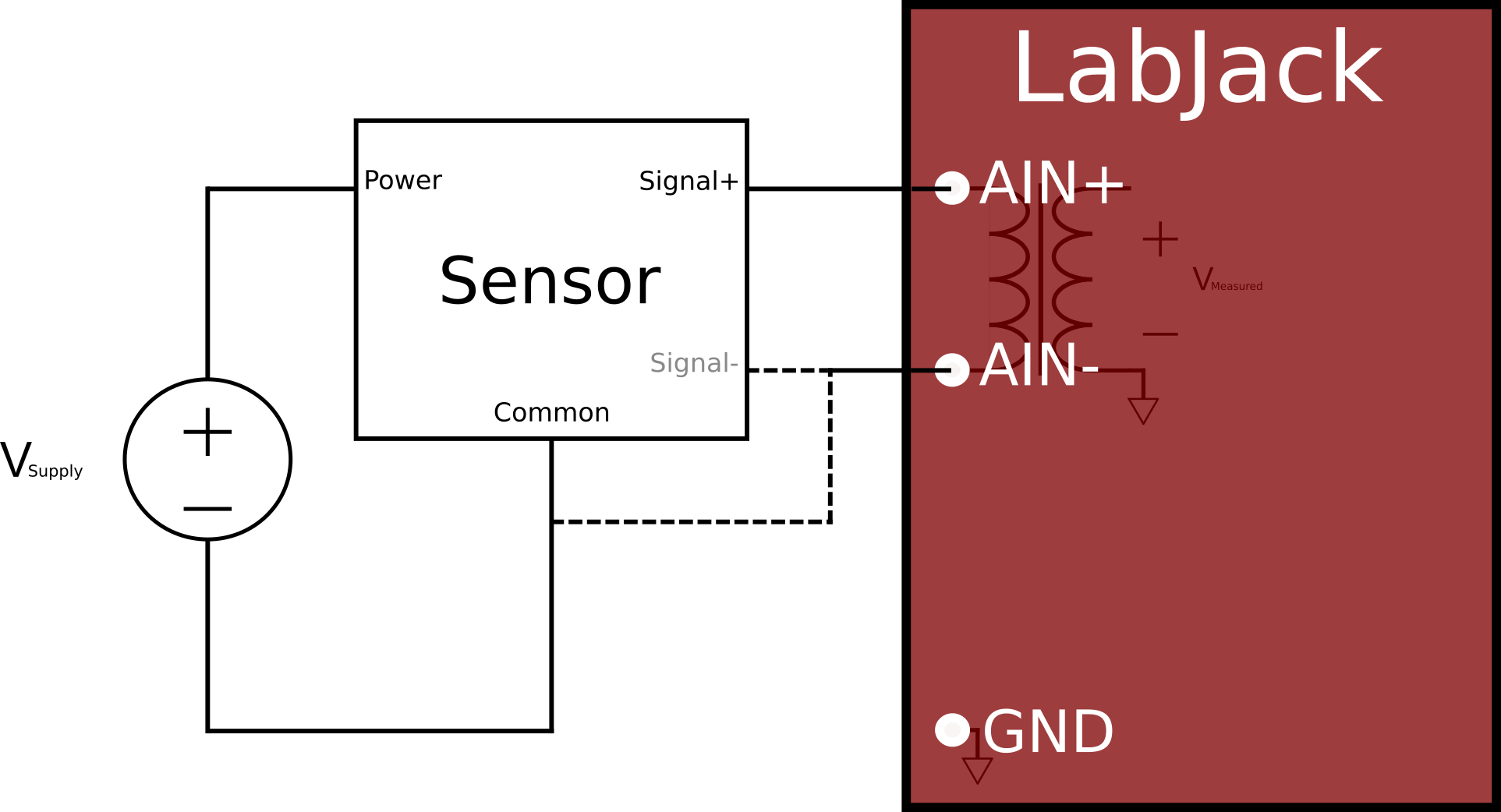Externally Powered Signals (App Note)
Externally powered signals derive power from batteries, external power supplies, or perhaps AC mains wall power. The most common example is a 3-wire sensor with DC voltage supply: Power, Common ground, and Signal. Power and Common connect to some DC power supply.
Typical Wiring
The sensor signal output should be connected to an appropriate input on the LabJack. You also usually need a connection from the sensor common ground to LabJack GND as shown in Figure 1.
Figure 1. Externally Powered Signal Without Isolated Inputs
If your LabJack has isolated analog inputs and the signal is analog, you would connect the sensor common (or signal- if applicable) to AINx- instead of GND as shown in Figure 2. Since isolated inputs do not need the sensor common connected to LabJack GND, the ground complications that are described below would not apply.

Figure 2. Externally Powered Signal With Isolated Analog Inputs
Ground Complications
If your LabJack inputs are not isolated, there could be additional complications that you must consider depending on the sensor grounding. For example, lets say that there is a "black box" sensor with a wire coming out that is defined as a 0-5 volt analog signal and a second wire labeled as ground. The signal is known to have 0-5 volts compared to the ground wire, but the complication is: what is the voltage of the box ground compared to the LabJack ground?
Isolated Signals
If the box is known to be electrically isolated from the LabJack, the box ground can simply be connected to the LabJack's GND. An example would be if the box was powered by an internal battery, and does not have any wires besides the signal and ground which are connected to AINx and GND on the LabJack.
Signal GND = LabJack GND
If the box ground is known to be the same as the LabJack GND, then perhaps only the one signal wire needs to be connected to the LabJack. However, it generally does not hurt to go ahead and connect the ground wire to the LabJack GND with a 100 Ω resistor to be safe. You definitely do not want to connect the grounds without a resistor. That would create ground loops, which could add substantial noise to your system.
Unknown Signal Grounding
If little is known about the box ground, a DMM can be used to measure the voltage of the box's ground compared to the LabJack's GND. As long as an extreme voltage is not measured, it is generally OK to connect the box's ground to the LabJack's GND, but again, it is a good idea to put in a 100 Ω series resistor to prevent large currents from flowing on the ground. Use a small wattage resistor (typically 1/8 or 1/4 watt) so that it will break if too much current does flow which may prevent your LabJack from being damaged in the process. The only current that should flow on the ground wire is the return of the analog input bias current, which is on the order of micro-amps (for the U3 & UE9) to nano-amps (for the U6).
In general, if there is uncertainty about the situation, a good approach is to use a DMM to measure the voltage on each signal/ground wire without any connections to the LabJack. If no large voltages are noted, connect the ground to the LabJack's SGND with a 100 Ω series resistor. Then again use the DMM to measure the voltage of each signal wire before connecting to the LabJack.
Minimize Ground Connections
It is recommended that you minimum the number of ground connections in your system. For instance, if you are connecting 8 sensors powered by the same external supply, or that are otherwise referred to the same external ground, only a single ground connection is needed to the LabJack. Perhaps the ground leads from the 8 sensors would be twisted together, and then a single wire would be connected to a 100 Ω resistor which is the connected to the LabJack's ground.
SGND
The SGND terminals available on many LabJack devices can be used instead of GND for externally powered signals. When connecting an externally powered signal to this terminal a series resistor is not needed as SGND is fused to prevent over-current, however a resistor will eliminate confusion that can be caused if the fuse is tripping and resetting so it is still a good idea.
Recommended AC to DC External PSUs
Two companies that produce good quality AC to DC switching PSUs are CUI and Mean Well. Their PSUs can be purchased in a variety of form factors: embeddable, chassis mount, and DIN rail to name a few. They can also be purchased with different power output specifications. There are many options available if a quick google search is performed and below is a list of a hand full of links to ~10W PSUs from CUI and Mean Well. that can easily be purchased from Mouser or Allied Electronics.
24V (~10W) out: CUI VSK-S10-24UA-T
15V (~10W) out: CUI VSK-S10-15UA-T
12V (~10W) out: CUI VSK-S10-12UA-T
9V (~10W) out: CUI VSK-S10-9UA-T
5V (~10W) out: CUI VSK-S10-5UA-T
24V (~15W) out: Mean Well USA RS-15-24
15V (~15W) out: Mean Well USA RS-15-15
12V (~15W) out: Mean Well USA RS-15-12
5V (~15W) out: Mean Well USA RS-15-5
For more PSU SKU options from CUI, reference their DIN Rail AC-DC Power Supply web pages. for more PSU SKU options from Mean Well, reference either their Enclosed AC-DC Switching PSU page or their DIN Rail AC-DC PSU page.
